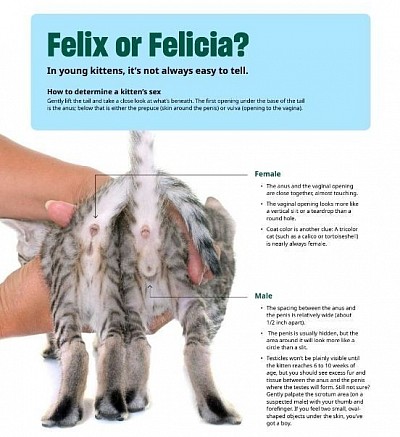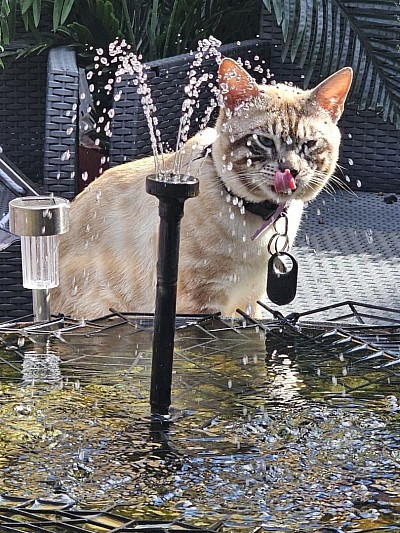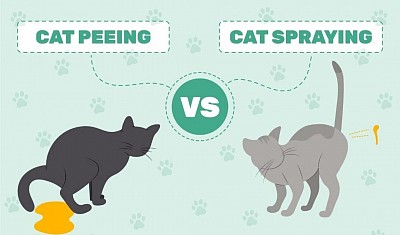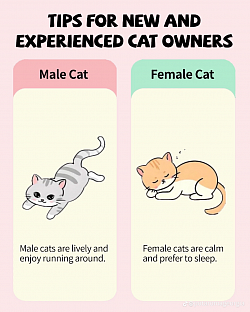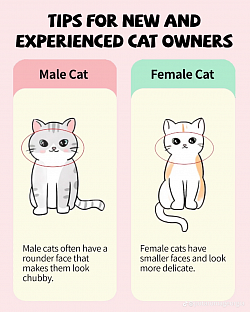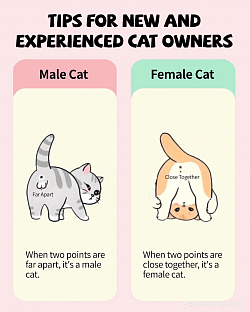Comparison of Female and Male Cats
Comparison of Female and Male Cats
Key distinctions between male and female cats are most pronounced in unneutered animals, primarily influenced by hormonal factors. Although spaying and neutering significantly diminish these differences, certain general trends persist in size, lifespan, and health risks. Ultimately, a cat’s individual personality plays a more crucial role than its sex.
Physical and Health Differences
Characteristic
| Male Cats (Toms) | Female Cats (Queens) | |
|---|---|---|
| Size | Generally larger and heavier, particularly if unneutered. | Typically smaller with a more slender physique. |
| Head and Jowls | Unneutered males often exhibit larger heads and prominent “tomcat jowls” due to testosterone. | Possess a more delicate facial structure and head shape. |
| Lifespan | On average, females tend to live 1 to 2 years longer. | Tend to have a slightly longer lifespan than males. |
| Health Risks | Unneutered males face higher risks of trauma from fighting and infectious diseases such as FIV. All males, especially neutered ones, have an increased risk of urinary blockages due to a narrower urethra. | Unspayed females are more susceptible to mammary tumours and uterine infections. |
| Coat Colour | : The orange tabby coat is significantly more prevalent in males, as the gene for orange fur is located on the X chromosome, and males require only one copy to express this colour. | Calico and tortoiseshell coat patterns are almost exclusively found in females, as they necessitate two X chromosomes to manifest. |
Behavioral Differences
| Characteristic | Male Cats | Female Cats |
|---|---|---|
| Affection and Play | Often characterised as more social, affectionate “lap cats,” and generally more playful, though individual variation is considerable. | Sometimes perceived as more independent or reserved, yet can be exceptionally loyal and affectionate once bonded. |
| Territorial Marking | Unneutered males are considerably more likely to spray urine to mark territory, producing a distinct, pungent odour. Neutering substantially reduces this behaviour. | While less frequent, females may also spray, particularly when in heat or under stress. |
| Territoriality | Unneutered males exhibit strong territorial instincts and are prone to fighting. Neutered males tend to be more relaxed and tolerant of other cats. | Females can be equally territorial, especially if unspayed. Spayed females generally display reduced aggression. |
| Roaming | Unneutered males are more inclined to roam extensively in search of mates, increasing their risk of injury. Neutering markedly curtails this behaviour. | Unspayed females also roam during heat cycles, though typically not as far or as long as unneutered males. |
| Heat Cycle | Male cats do not experience heat cycles but continuously seek mates. | Unspayed females undergo heat cycles multiple times annually, often becoming more vocal (yowling), restless, and affectionate during these periods. |
Impact of Neutering and Spaying
Most behavioural differences are hormonally driven and are significantly reduced or eliminated through spaying and neutering. Additionally, the health risks associated with reproduction are mitigated, thereby enhancing a cat’s lifespan.
Consequently, when selecting a cat, prioritising its individual personality, breed, and upbringing is far more important than focusing on its sex.
A Comparative Look at Female and Male Cats
A Comparative Analysis of Female and Male Cats
While each cat possesses a distinct personality, certain general differences are commonly observed between the sexes. These characteristics may be influenced by whether the cat has been spayed or neutered.
Physical Differences
Size and Build: Male cats (toms) are generally larger and more muscular than female cats (queens), featuring broader heads, thicker necks, and greater overall weight. Female cats tend to be smaller and more slender. Facial Features: Intact male cats often develop "stud jowls," a pronounced, thick padding on their cheeks, which is less common in neutered males and absent in females.Vocalisation: Female cats in heat are typically very vocal, producing loud, wailing calls to attract mates; this behaviour ceases in spayed females. Male cats may also vocalise, though their calls usually relate to territorial or mating behaviours and differ in tone.
Personality and Temperament
Affection and Sociability: Male cats are frequently perceived as more openly affectionate and social, often seeking attention and enjoying lap time. Female cats can be equally affectionate but may be more selective regarding when and how they express affection. Independence: Female cats are sometimes regarded as more independent and reserved, often preferring personal space and some distance compared to males. However, this is not a universal trait, as many female cats are notably cuddly. Playfulness: Both sexes exhibit playfulness, especially during youth. Male cats may engage more in rough-and-tumble play, whereas female cats might prefer more strategic or hunting-oriented games.
Behavioral Traits
Territoriality: Intact male cats are highly territorial and may mark their territory through spraying (urine marking). They are also more prone to roaming and conflicts with other males. Neutering substantially reduces these behaviours. Spaying and Neutering: These procedures significantly influence behaviour. Spayed females no longer experience heat cycles, eliminating associated loud vocalisations and restlessness. Neutered males demonstrate marked decreases in spraying, roaming, and aggression. Maternal Instincts: Unspayed female cats often display strong maternal instincts, which can manifest as protectiveness or a more serious demeanour, even when not pregnant.Interaction with Other Cats: Female cats may be more assertive and protective of their territory and resources, particularly around other females. Neutered male cats tend to be more sociable with other cats, regardless of sex.
Urination and Spraying Behaviors in Cats: Understanding and Management
Managing a cat that urinates inappropriately within the home can be highly challenging. Many cat owners may not recognise the distinction between urination and spraying. Although these behaviours may appear similar, understanding their differences is crucial, as they stem from different causes and require distinct approaches for resolution.
Your veterinarian can assist in identifying the specific issue; however, they will likely require detailed information from you. It is important to monitor your cat’s behaviour, litter box habits, and any recent environmental changes. The following provides an overview of the differences between spraying and inappropriate urination in cats.
Overview of Spraying
Spraying is an instinctual behaviour predominantly observed in male cats, especially those that are intact, although female cats in heat may also exhibit this behaviour. Regardless of sex, spraying is generally considered undesirable by pet owners.
Why Do Cats Spray?
Cats spray to mark their territory and communicate their presence to other cats through pheromones and scent. While most cats spray to establish territory or signal sexual receptivity, spraying can also occur in response to stress or perceived threats. Notably, spraying is more common among intact cats.
Characteristics of Spraying Behaviour
When spraying, cats typically target vertical surfaces such as walls or fences. They often hold their tails upright and may vibrate or quiver the tail near its base. Male cats, particularly tomcats, tend to produce urine with a stronger odour when spraying.
Neutering can significantly reduce both the intensity of the urine odour and the frequency of spraying. Spraying generally involves the release of small urine quantities rather than emptying the bladder completely. Cats may repeatedly spray the same location but also explore new areas to mark.
It is also common for cats that urinate inappropriately to choose unusual locations such as bathtubs and sinks.
Comparison: Spraying vs. Peeing
| Spraying | Peeing |
|---|---|
| Common in intact cats | it can occur in any cat |
| Marks territory or signals stress | Indicates stress or illness |
| Occurs on vertical surfaces | Can occur on any surface |
| Often accompanied by strong-smelling urine | usually normal-smelling urine |
Conclusion
Spraying is frequently associated with intact male cats but may occur in any cat. Inappropriate urination can affect any cat and often signals stress or an underlying medical condition. Both behaviours may necessitate veterinary evaluation and intervention.
Careful observation of your cat’s litter box usage can aid in early detection of problems. This information is valuable for both you and your veterinarian in diagnosing the cause of spraying or inappropriate urination. Maintaining a stable, calm environment with ample cosy hiding spots can help reduce stress and minimise the occurrence of these behaviours.

